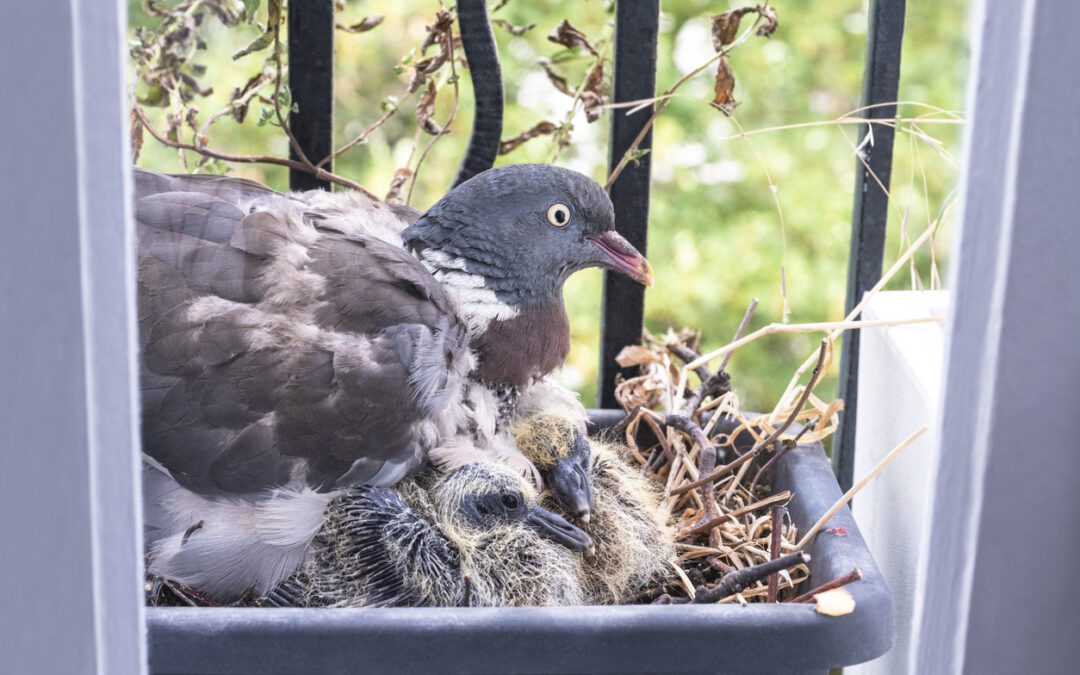
by Pigeon Patrol | Sep 25, 2024 | Bird Netting, Pigeon Droppings, Pigeon Predators, Pigeon Spikes
From sidewalks messed with droppings to gutters filled with feathers, birds aren’t always welcome in some public places. As beautiful as they can be individually, a large group of birds gathering atop a building or nesting in air vents can create a danger for themselves and the public.
BirdFlite wires keep large birds from gathering on a building’s ledge. Photos courtesy of Bird Barrier.
Bird Barrier Inc. of Carson, Calif., has developed several ways to keep birds off building ledges and awnings without harming them and with little to no visual impact.
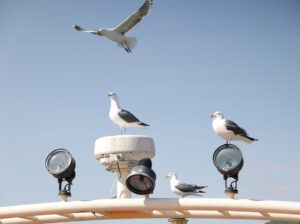
Four gulls observe from a sightseeing cruiser on Toyako, a caldera lake. Spring afternoon in Abuta District.
“You probably won’t even notice them,” says Monique Thorsell, marketing director for Bird Barrier, of the company’s various, and often strange-looking, bird deterrents.
Some of their products — such scarecrow-like screech owl decoys — have been used for years. Others — like the Daddi Long Legs with its many thin, wavy wires — look more like alien technology.
Though Bird Barriers has been around for eight years, Thorsell says some of its experts have been working in bird control for 20 years. “It has grown to be a very hot market in the last seven to eight years,” she said. As more development moves into the suburban areas, birds are finding their old nesting grounds are now covered in pavement. “We’re decreasing their natural habitat,” she says. “There are more conflicts being created.”
In recent years, increasing populations of Canadian Geese have left their mark — and droppings — on public parks and golf courses. Some are concerned the birds will destroy the landscaping and vegetation — others worry about diseases spreading through bird droppings.
In the city, birds create problems when they gather on rooftops where their feathers and droppings get into air vents, either circulating bacteria or causing mechanical problems. “You really want to keep birds off the air intake valves and air conditioning units,” Thorsell says. A lot of times they will clog up gutters, creating standing water that can wear down a roof.
The issue isn’t really with one or two birds hanging out on a ledge outside of the building, she says. “But if you have them in an area around the air conditioning unit or if you have a couple hundred birds on the building, you need to take a look at solving the issue.”
Contractors and homeowners can purchase products on Bird Barriers’ Web site. The company will provide teaching tools on which method will work best for the situation and how to install the product. “We don’t actually do the installs,” she said, but the company has trained more than 15,000 installers across the country.
Different products are recommended for different situations. The StealthNet is made of polyethylene twine and steel installation hardware, so it is difficult for the public to see from even a few feet away. Designed for all bird species and heavy use, the netting is attached to a pre-installed cable system. Though great for keeping birds off rooftops and air conditioning units, the installation of the StealthNet is rather involved.
Another product, Bird-Flite Spikes, comes in one-foot lengths and three different width configurations. The product is designed to keep birds the size of pigeons or larger off ledges, while leaving room for small songbirds. Made of stainless steel and polycarbonate, the base can be easily glued or screwed onto the surface.
Daddi Long Legs
The many wires of the Daddi Long Legs work to deter seagulls from landing on a boat.
The spider-like Daddi Long Legs is made of stainless steel and Delrin plastic. This product is often used on boats, atop streetlights and outdoor shade umbrellas to deter bigger birds from landing. “Not starlings or sparrows,” Thorsell says. “They can actually hang on the wires.”
The cost of installing a bird-deterrent system can vary depending on the product used and the extent of the project. “The homeowner that has a problem on their window ledge could spend $20 to $30,” she said, whereas keeping birds out of airport hangers could cost more than $100,000. “In general, the solution to the problem is anywhere from $500 to $2,500.”
At Seattle’s Key Arena, Bird Barrier products such as the Bird Flight and Bird Shock are used to keep birds away from and out of the building. While Bird Shock does generate an electric shock, Thorsell says it won’t actually harm the birds. “It sends a little conditioning shock, similar to a static-electricity shock,” she says.
In fact, the Humane Society and the Fund for Animals have endorsed Bird Barrier because the company provides non-harmful methods to deter birds. “We have the only completely humane product line in the business,” Thorsell says.
Here’s why some pigeons do backflips
At least five genes are involved in making parlor roller pigeons do backward somersaults
A brownish-red roller pigeon does backward somersaults from left to right across a white background.
Parlor roller pigeons like this one have a movement disorder that prevents them from flying. At least five genes are involved in making the birds do backward somersaults, new research suggests.
These roller pigeons come in two varieties: Flying rollers such as Birmingham rollers, which fly but do long tumbling runs toward the ground before resuming flight, and parlor rollers, which can’t fly but instead backflip along the ground. Many Persian poems say the pigeons perform the acrobatics because the birds are happy, but Samani says the truth is darker. “This is definitely a movement disorder, and it does not have any good aspects to it,” she says. The disorder is progressive, appearing soon after hatching and gradually getting worse until the birds can’t fly.
A smiling young woman, Atoosa Samani, with shoulder-length dark hair holds a small green bird with a yellow belly in her right hand. She is wearing a maroon coat and dark mauve stocking cap.
In addition to studying pigeon genetics, Atoosa Samani, pictured here holding a Wilson’s warbler, also volunteers with a bird banding group and enjoys bird watching. “I love birds,” she says. But she confesses that pigeons are her favorites.
Courtesy of A. Samani
Her colleagues confirmed backflipping is a recessive trait by breeding racing homer pigeons with parlor rollers; none of the hybrid offspring rolled. When hybrid birds were bred together, about 4 out of 10 of the offspring did somersaults when forced to fly, Samani said at the conference.
Samani used two different statistical methods to locate genes that make the pigeons tip tailfeather over teakettle. She found five large stretches of DNA containing hundreds of genes. But none of the genes in those areas had mutations that could account for the tumbling.
So she looked at gene activity in the birds’ brains and found nearly 2,000 genes that become either more or less active in the brains of parlor rollers than in two breeds of nonrolling pigeons.
Pigeon Patrol
Pigeon Patrol Products & Services is the leading manufacturer and distributor of bird deterrent (control) products in Canada. Pigeon Patrol products have solved pest bird problems in industrial, commercial, and residential settings since 2000, by using safe and humane bird deterrents with only bird and animal -friendly solutions. At Pigeon Patrol, we manufacture and offer a variety of bird deterrents, ranging from Ultra-flex Bird Spikes with UV protection, Bird Netting, 4-S Bird Gel and the best Ultrasonic and audible sound devices on the market today.
Canada’s top wholesaler for bird deterrent products for twelve consecutive years.
Contact us at 1- 877– 4– NO-BIRD, (604) 585-9279 or visit our website at https://www.pigeonpatrol.ca/
Bird Gone, Pigeon Gone, Pigeon problems, pigeon spikes, 1-877-4NO-BIRD, 4-S Gel, Bird Control, Pigeon Control, bird repellent, Bird Spikes, sonic bird repellent, stainless steel bird spikes, bird spikes Vancouver, Ultra Sonic Bird Control, Bird Netting, Plastic Bird Spikes, Canada bird spike deterrents, Pigeon Pests, B Gone Pigeon, Pigeon Patrol, pest controller, pest control operator, pest control technician, Pigeon Control Products, humane pigeon spikes, pigeon deterrents, pigeon traps, Pigeon repellents, Sound & Laser Deterrents, wildlife control, raccoon, skunk, squirrel deterrent, De-Fence Spikes, Dragons Den, Pigeon, Pigeon Patrol, Pigeons Roosting, Vancouver Pigeon Control, Bird Spikes, Bird Control, Bird Deterrent, Pigeon Deterrent, Surrey Pigeon Control, Pest, Seagull deterrent Vancouver Pigeon Blog, Birds Inside Home De-fence, Pigeon Nesting, Bird Droppings, Pigeon Dropping, woodpecker control, Keep The Birds Away, Birds/rats, seagull, pigeon, woodpecker, dove, sparrow, pidgeon control, pidgeon problem, pidgeon control, flying rats, pigeon Problems, bird netting, bird gel, bird spray, bird nails, bird guard, Pigeon control, Bird deterrents, Pigeon deterrents, Bird control, solutions, Pigeon prevention, Pigeon repellent, Bird proofing, Pest bird management, Pigeon spikes, Bird netting, Humane bird control, Bird exclusion, Urban bird control, Anti-roosting devices, Pigeon removal, Bird barriers
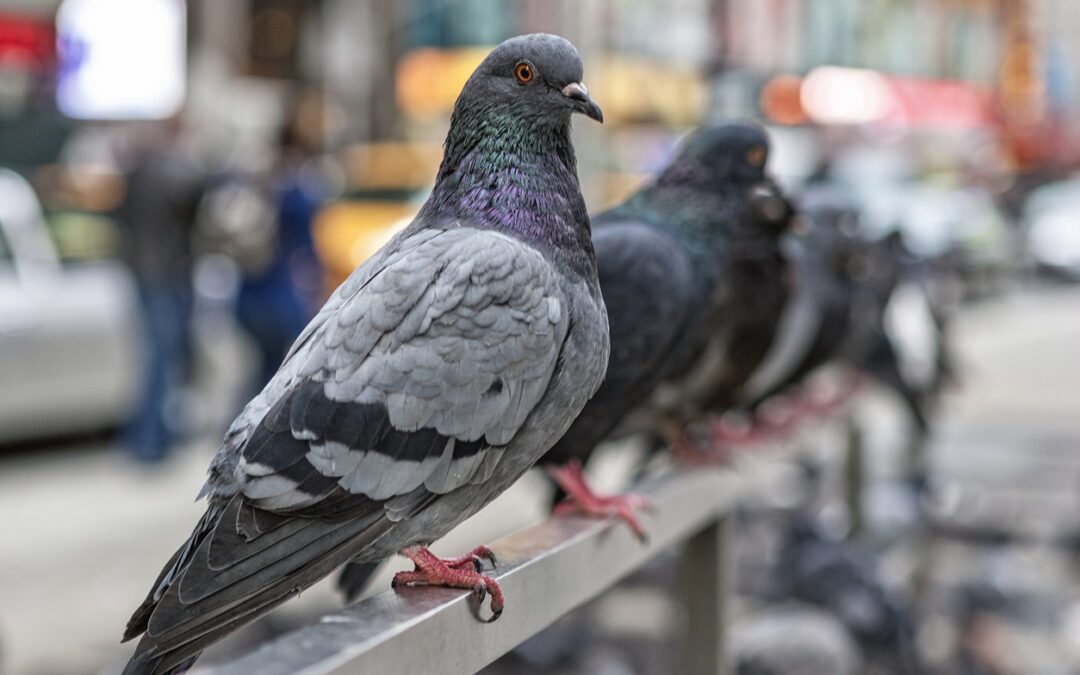
by Pigeon Patrol | Sep 25, 2024 | Animal Deterrent Products, Bird Deterrent Products, Bird Law, Bird Netting, Columbidae
Feral pigeons and certain species of gull, for example the Herring Gull and Lesser Black-Back Gull are potentially a source of risk to health and safety in the urban environment. A range of diseases have been shown to be carried by birds living in urban and suburban environments.
Pigeons and seagulls will deface buildings by their droppings deposited and nesting materials.
The feral pigeon use buildings throughout cities as a sheltered roosting site while waiting to feed at first light, on debris from waste management bins in the domestic and commercial sectors.
Both Herring Gulls and Lesser Black-Back Gulls are becoming an increasing problem in Dublin and surrounding areas, nesting on flat rooftops. They have become aggressively protective of their territory, especially during their breeding cycle.
Legal status
Unlike most other pest species, birds have legislative protection unless it can be provided that their presence is detrimental to man in some way.
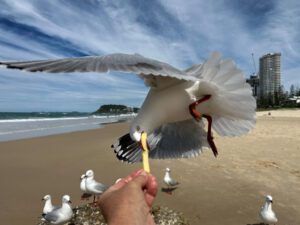
Seagull flying in to to eat french fry chip.
Under the Wildlife (Amended) Act 2000 all wild birds, their eggs, nests and habitat are protected. However, member states may derogate from the provisions in the directive, where there is no other satisfactory solution, for the following reasons:
In the interests of public health and safety
In the interest of air safety
To prevent serious damage to crops, livestock, forests, fisheries and water
For the protection of flora and fauna
In Ireland, General Licences, issued and revised, annually by the Department list the birds that can be taken. The licences also state the reasons for such action, methods of control and that the work must be carried out by an authorised person (authorised person means the owner, occupier or someone authorised b the owner or occupier in writing).
These licences do not have to be applied for. They are a legislative means of removing the protection of certain birds, regarded as pests, from the general protection afforded them through the Wildlife (Amended) Act 2000.
Population control
Reduction in numbers by one of the approved methods, shooting, trapping etc will provide only short-term relief. This method should only provide temporary relief until proofing work is complete, or to clear derelict buildings of pest birds prior to demolition.
Management of pest birds can be divided into three distinct categories:
Reduction / removal of food sources
The number of birds in an area will be directly influenced by the food source available. Therefore, good waste management and discouraging members of the public from feeding the birds (mainly feral pigeons will naturally reduce the bird numbers over a period of time.
Removal of roosting sites
Design of new buildings should take into consideration ledges, windowsills and any other feature that might provide roosting sites for birds. An angle of 45 degrees or more will prevent birds from roosting. Maintenance of existing buildings should be carried out to remove potential ingress points for feral pigeons. These would include missing rooftiles, broken windows and areas where maintenance work has been carried out and holes left in the fabric of the building.
Roofs should be designed and detailed specifically to exclude birds by keeping all gaps and openings below 20mm
Proofing against bird nesting and roosting
Proofing measures such as netting and stainless-steel spikes can be used to deter birds from roosting on buildings.
Netting mesh sizes for bird proofing will vary according to the species of bird. As a guide, the following mesh sizes are recommended:
Sparrows and similar size birds – 19mm mesh size
Starlings – 28-30mm mesh size
Pigeons – 50mm mesh size
Gulls – 75mm mesh size
Spike systems will deter birds from roosting on ledges that cannot be made inaccessible by netting. They should be fixed in a manner that will ensure that the ledge is adequately covered by the spikes.
Bird proofing is specialist work. An experienced installer should be consulted for advice and proofing strategies.
It should be noted that birds other than those listed on the general licences cannot be prevented from accessing their nest site during the breeding season. To do so would be a breach of the Wildlife (Amended) Act 2000 and prosecution could follow.
Urban pest bird control Pigeons is a complex subject and requires an integrated approach which will include waste management regimes to minimise attractive food sources; maintenance and design of buildings that will reduce potential roosting and nesting sites and proofing strategies that will exclude pest birds from priorities areas.
Pigeons AKA ‘Rats with Wings’
Why do we dread these pests over other animals?
Since the 1930s pigeons have been causing havoc to our cities. From nesting on roofs to defecating buildings. They are commonly known as ‘Rats with Wings’ but do we have reason to despise these birds? Let us take a look
Noise
These pesky birds invade spaces that are not designed for them. They have settled in urban areas and industrial estates and are comfortable making their nest in man made structures. Their short legs and hind toes permit easy perching on pipes and ledges.
Faeces
Not only do they invade our space they also destroy it with their droppings. Their waste is highly acidic and will corrode metal and concrete. Pigeons also carry mites which can cause skin disorders, while dirt from their feathers can exacerbate respiratory problems.
Disease
Most importantly they are a health risk to us. Pigeons and their excretion spread over 60 different diseases. Histoplasmosis, Salmonella and E.coli to name just a few.
Image
A pigeon infestation will promote a bad company image. Seeing a flock of pigeons nesting on the roof of any building or its ledge does not portray a top company image.
Damage
Pigeons nest in drain gutters, blocking them causing damage. They also nest near cables which could lead to a serious fire hazard. Pigeon activity around buildings often leads to structural damage as these resourceful pests can lift roof coverings to make an entry.
How do we control these pesky pests?
In the 20th century, pigeons were controlled by killing them however nowadays Bird Control Pigeons is much more humane. Controlling them now means preventing them nesting on YOUR building and moving them elsewhere. Our highly trained staff at Central Pest Control can help in moving these birds from your building by putting netting or bird wiring of any shape or size to fit your pest control needs depending on the area invaded.
Did you know? A pigeon dispenses over 10 kg of dung a year!
Pigeon Patrol
Pigeon Patrol Products & Services is the leading manufacturer and distributor of bird deterrent (control) products in Canada. Pigeon Patrol products have solved pest bird problems in industrial, commercial, and residential settings since 2000, by using safe and humane bird deterrents with only bird and animal -friendly solutions. At Pigeon Patrol, we manufacture and offer a variety of bird deterrents, ranging from Ultra-flex Bird Spikes with UV protection, Bird Netting, 4-S Bird Gel and the best Ultrasonic and audible sound devices on the market today.
Canada’s top wholesaler for bird deterrent products for twelve consecutive years.
Contact us at 1- 877– 4– NO-BIRD, (604) 585-9279 or visit our website at https://www.pigeonpatrol.ca/
Bird Gone, Pigeon Gone, Pigeon problems, pigeon spikes, 1-877-4NO-BIRD, 4-S Gel, Bird Control, Pigeon Control, bird repellent, Bird Spikes, sonic bird repellent, stainless steel bird spikes, bird spikes Vancouver, Ultra Sonic Bird Control, Bird Netting, Plastic Bird Spikes, Canada bird spike deterrents, Pigeon Pests, B Gone Pigeon, Pigeon Patrol, pest controller, pest control operator, pest control technician, Pigeon Control Products, humane pigeon spikes, pigeon deterrents, pigeon traps, Pigeon repellents, Sound & Laser Deterrents, wildlife control, raccoon, skunk, squirrel deterrent, De-Fence Spikes, Dragons Den, Pigeon, Pigeon Patrol, Pigeons Roosting, Vancouver Pigeon Control, Bird Spikes, Bird Control, Bird Deterrent, Pigeon Deterrent, Surrey Pigeon Control, Pest, Seagull deterrent Vancouver Pigeon Blog, Birds Inside Home De-fence, Pigeon Nesting, Bird Droppings, Pigeon Dropping, woodpecker control, Keep The Birds Away, Birds/rats, seagull, pigeon, woodpecker, dove, sparrow, pidgeon control, pidgeon problem, pidgeon control, flying rats, pigeon Problems, bird netting, bird gel, bird spray, bird nails, bird guard, Pigeon control, Bird deterrents, Pigeon deterrents, Bird control, solutions, Pigeon prevention, Pigeon repellent, Bird proofing, Pest bird management, Pigeon spikes, Bird netting, Humane bird control, Bird exclusion, Urban bird control, Anti-roosting devices, Pigeon removal, Bird barriers
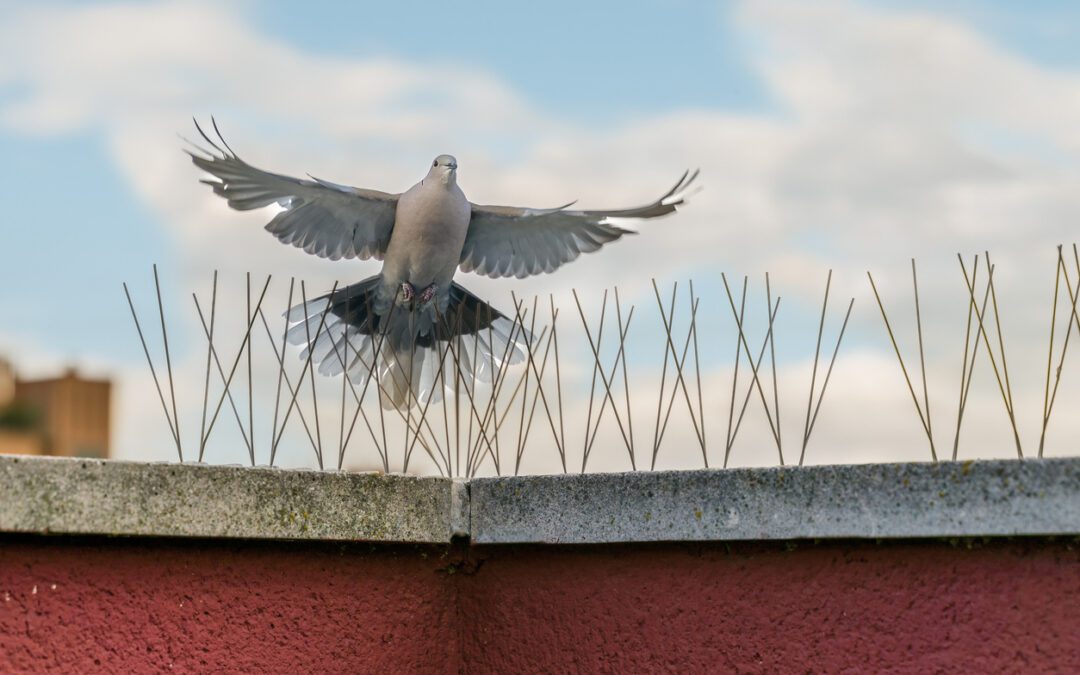
by Pigeon Patrol | Sep 25, 2024 | Bird Netting, Pigeons in the News, Raccoons, Sparrows, UltraSonic Bird Control
Pigeons are our most common urban bird.
They are amazingly resourceful creatures, able to survive in the midst of predatory humanity.
Even so, up to 35% of a local population may perish annually from natural causes and predators.
Pigeons flock together in large numbers to protect themselves against, cats, rats and foxes.
Even when times are tough and the weather is freezing and stormy, they co-operate with each other and readily accept outsiders into their flock.
They have easy temperaments and are adaptable and hardy, which no doubt accounts for their ability to maintain numbers.
The most widespread misconception about urban pigeons is that they are carriers of disease.
The truth is that the vast majority of people are at little or no health risk and probably have a greater chance of being struck by lightning than contracting disease from a pigeon.
Pigeons pair for life.
Both parents take an equal role in caring for their young.
The chicks are helpless when first hatched and are fed for the first few days on ‘pigeon milk’ regurgitated from both parents’ throats.
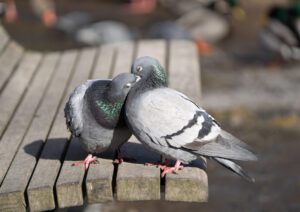
Two pigeons on a park bench in mating season.
The phenomenal navigational abilities of pigeons largely depend on their keen vision and memory for landmarks. Over the centuries these qualities have become legendary.
Pigeon Patrol
Pigeon Patrol Products & Services is the leading manufacturer and distributor of bird deterrent (control) products in Canada. Pigeon Patrol products have solved pest bird problems in industrial, commercial, and residential settings since 2000, by using safe and humane bird deterrents with only bird and animal -friendly solutions. At Pigeon Patrol, we manufacture and offer a variety of bird deterrents, ranging from Ultra-flex Bird Spikes with UV protection, Bird Netting, 4-S Bird Gel and the best Ultrasonic and audible sound devices on the market today.
Canada’s top wholesaler for bird deterrent products for twelve consecutive years.
Contact us at 1- 877– 4– NO-BIRD, (604) 585-9279 or visit our website at https://www.pigeonpatrol.ca/
Bird Gone, Pigeon Gone, Pigeon problems, pigeon spikes, 1-877-4NO-BIRD, 4-S Gel, Bird Control, Pigeon Control, bird repellent, Bird Spikes, sonic bird repellent, stainless steel bird spikes, bird spikes Vancouver, Ultra Sonic Bird Control, Bird Netting, Plastic Bird Spikes, Canada bird spike deterrents, Pigeon Pests, B Gone Pigeon, Pigeon Patrol, pest controller, pest control operator, pest control technician, Pigeon Control Products, humane pigeon spikes, pigeon deterrents, pigeon traps, Pigeon repellents, Sound & Laser Deterrents, wildlife control, raccoon, skunk, squirrel deterrent, De-Fence Spikes, Dragons Den, Pigeon, Pigeon Patrol, Pigeons Roosting, Vancouver Pigeon Control, Bird Spikes, Bird Control, Bird Deterrent, Pigeon Deterrent, Surrey Pigeon Control, Pest, Seagull deterrent Vancouver Pigeon Blog, Birds Inside Home De-fence, Pigeon Nesting, Bird Droppings, Pigeon Dropping, woodpecker control, Keep The Birds Away, Birds/rats, seagull, pigeon, woodpecker, dove, sparrow, pidgeon control, pidgeon problem, pidgeon control, flying rats, pigeon Problems, bird netting, bird gel, bird spray, bird nails, bird guard, Pigeon control, Bird deterrents, Pigeon deterrents, Bird control, solutions, Pigeon prevention, Pigeon repellent, Bird proofing, Pest bird management, Pigeon spikes, Bird netting, Humane bird control, Bird exclusion, Urban bird control, Anti-roosting devices, Pigeon removal, Bird barriers

by Pigeon Patrol | Sep 25, 2024 | Bird Deterrent Products, Bird Netting, Pigeon Control, Pigeon Droppings, Pigeon Patrol's Services, Pigeon Predators
There are at least two potential consumer uses for lasers outdoors, pointing out stars in the sky and dispersing birds. This page discusses tips for deterring and dispersing birds.
Summary
LaserPointerSafety.com does not recommend that ordinary consumers use lasers to scare away unwanted birds. The right type of laser with a wide, low-powered beam is not readily available so there are too many potential safety problems for the birds, for the laser user, and for bystanders.
Also, there is a chance of accidentally having the beam be on or near an aircraft; this is illegal in many countries and jurisdictions. Finally, some species of birds may be only temporarily repelled by lasers; after a few minutes or within a day, studies indicate they will return.
Bird deterrence and dispersal
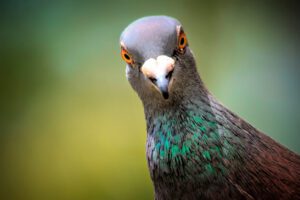
Domestic Pigeon looking at camera
Some consumers have asked about using lasers for bird dispersal.
A September 2003 U.S. Department of Agriculture publication, “Use of Lasers in Avian Dispersal” (available here or here) says that lasers are “safe and effective species-specific alternatives to pyrotechnics, shotguns, and other traditional avian dispersal tools.” A key phrase is “species-specific”. For example, a 2002 USDA study of crows (listed below) concluded that lasers do not work for more than a few minutes of dispersal, and are therefore not recommended for crows.
LaserPointerSafety.com believes there is a difference between serious, professional use, and consumers ordering possibly over-powered lasers off the Internet and simply waving them into trees and the sky. This is especially true in today’s environment where authorities are very sensitive to lasers being aimed into the air by ordinary citizens.
Our recommendation is that consumers should not use lasers against birds, especially Class 3B and Class 4 lasers (output power of 5 milliwatts or above). If a person feels they must try this, it should be done very carefully, with continuous monitoring of the sky so that aircraft are not accidentally targeted.
Pigeon Patrol
Pigeon Patrol Products & Services is the leading manufacturer and distributor of bird deterrent (control) products in Canada. Pigeon Patrol products have solved pest bird problems in industrial, commercial, and residential settings since 2000, by using safe and humane bird deterrents with only bird and animal -friendly solutions. At Pigeon Patrol, we manufacture and offer a variety of bird deterrents, ranging from Ultra-flex Bird Spikes with UV protection, Bird Netting, 4-S Bird Gel and the best Ultrasonic and audible sound devices on the market today.
Canada’s top wholesaler for bird deterrent products for twelve consecutive years.
Contact us at 1- 877– 4– NO-BIRD, (604) 585-9279 or visit our website at https://www.pigeonpatrol.ca/
Bird Gone, Pigeon Gone, Pigeon problems, pigeon spikes, 1-877-4NO-BIRD, 4-S Gel, Bird Control, Pigeon Control, bird repellent, Bird Spikes, sonic bird repellent, stainless steel bird spikes, bird spikes Vancouver, Ultra Sonic Bird Control, Bird Netting, Plastic Bird Spikes, Canada bird spike deterrents, Pigeon Pests, B Gone Pigeon, Pigeon Patrol, pest controller, pest control operator, pest control technician, Pigeon Control Products, humane pigeon spikes, pigeon deterrents, pigeon traps, Pigeon repellents, Sound & Laser Deterrents, wildlife control, raccoon, skunk, squirrel deterrent, De-Fence Spikes, Dragons Den, Pigeon, Pigeon Patrol, Pigeons Roosting, Vancouver Pigeon Control, Bird Spikes, Bird Control, Bird Deterrent, Pigeon Deterrent, Surrey Pigeon Control, Pest, Seagull deterrent Vancouver Pigeon Blog, Birds Inside Home De-fence, Pigeon Nesting, Bird Droppings, Pigeon Dropping, woodpecker control, Keep The Birds Away, Birds/rats, seagull, pigeon, woodpecker, dove, sparrow, pidgeon control, pidgeon problem, pidgeon control, flying rats, pigeon Problems, bird netting, bird gel, bird spray, bird nails, bird guard, Pigeon control, Bird deterrents, Pigeon deterrents, Bird control, solutions, Pigeon prevention, Pigeon repellent, Bird proofing, Pest bird management, Pigeon spikes, Bird netting, Humane bird control, Bird exclusion, Urban bird control, Anti-roosting devices, Pigeon removal, Bird barriers

by Pigeon Patrol | Sep 25, 2024 | Bird Law, Bird Netting, Bird Spikes, Columbidae, Doves
The Pink Pigeon is no longer Endangered. But how did conservationists achieve this, and is it sustainable? Dr Vikash Tatayah, Conservation Director, Mauritian Wildlife Foundation (BirdLife Partner) reports from the field…
Last year, one of Mauritius’ best-loved birds hit a milestone that delighted the conservation world. In the 2018 Red List update, the Pink Pigeon Nesoenas mayeri was downlisted from Endangered to Vulnerable, building upon the success of 2000, when it was downlisted from Critically Endangered to Endangered. But behind the scenes of this happy news lies over 30 years of gruelling devotion, with conservationists tackling the numerous threats to the pigeon from every possible angle in their bid to bring it back from the brink.
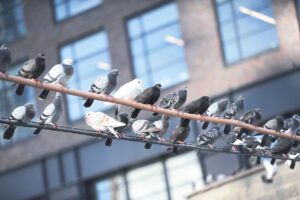
Pigeons in the city
For a while, we were worried it might go the same way as its fellow Mauritian endemic, the Dodo Raphus cucullatus. An even closer relative, the Reunion Pigeon Nesoenas duboisi, went extinct on the neighbouring Reunion Island in the late 18th century thanks to introduced cats and rats. The Pink Pigeon now holds the unenviable title of the last native pigeon in the whole Mascarene archipelago.
Predictably, it was the arrival of humans that heralded the Pink Pigeon’s decline. The species was once widely distributed across Mauritius, but by the 19th century its population had become extremely fragmented and confined to the upland forests. Humans had destroyed native vegetation to the extent that only 1.5% of the original, good-quality forest remained. They also hunted the plump bird and introduced a panoply of predators such as Black Rat Rattus rattus, Small Indian Mongoose Herpestes auropunctatus and Crab-eating Macaque Macaca fascicularis.
It wasn’t just animal predators: what little forest remained was soon invaded by non-native plants such as Chinese Guava Psidium cattleianum and the privet species Ligustrum robustum which choke vegetation, preventing the regeneration of native plants. By the mid-1970s, the species had plummeted to a single population of 20 birds in the upland forest of Black River Gorges, an area now known as Pigeon Wood. Just 12 Pink Pigeons remained in 1986, and of the five nesting attempts recorded that year, all were thwarted by rats. The wild population hit an all-time low of nine birds in 1990. The chances for long-term survival of the species looked bleak.
But the Mauritian Wildlife Foundation wasn’t going to let it go without a fight. With help from organisations across the world [see With Thanks, below], we set up an intensive conservation programme starting with captive breeding set up in 1976, followed by the first wild releases in 1987. We now have nine subpopulations centred around our field stations. Six of these are within the Black River Gorges National Park, close to the original Pigeon Wood. A sub-population can be found on the predator-free nature reserve island Ile aux Aigrettes, and two additional subpopulations are being created on private land at Ferney on the east of Mauritius and in Chamarel Ebony Forest in the south west. The purpose of these captive-reared birds is to bolster wild populations, and we encourage the dispersal of birds between the different areas in order to maintain genetic diversity. In total we now have 470 wild Pink Pigeons at these sites, a dramatic improvement compared to the species’ darkest hour.
Captive-bred chicks like these are released to bolster wild populations © MWF
But captive-breeding won’t help unless the wild habitat is made safe for these newcomers. That’s why wild populations are carefully managed using a three-pronged technique. Firstly, every Pink Pigeon is ringed with its own metal ID band and unique plastic colour combination. Each bird can therefore be identified and followed individually. All nests are checked regularly and the results documented. A large dataset has now been collected and continues to grow. This precise information helps us to understand in more depth the factors affecting the survival of the Pink Pigeon, and how to shape our management strategies accordingly.
Another priority is food. The Pink Pigeon is herbivorous, feeding mainly on fruit, leaves and flowers. But its natural habitat is so degraded that the birds are often unable to find enough food to support themselves. In order to supplement their diet, whole wheat and cracked maize is provided at each of the field sites. The food is placed on specially-designed platforms to prevent other species from obtaining it.
Introduced predators are, without a doubt, a major limiting factor to the survival of this species. Much energy is devoted to removing or controlling them from around the field sites. We are also researching and tackling diseases, in particular trichomonosis, an illness introduced by alien pigeons that can be especially fatal to Pink Pigeon chicks.
In the long term, large areas of forest will need to be restored so that the Pink Pigeon can spread into the uplands and breed in safe nesting sites with fewer predators. But for now, we are working on reinforcing numbers at the recently-created release sites. In order to increase genetic diversity, birds from captive populations in Europe will be repatriated to Mauritius. Research has shown that these birds have genetic variations no longer found in the wild population.
We are constantly seeking to improve our knowledge of the Pink Pigeon’s biology and behaviour, conducting studies into factors limiting the recovery of this species. We have examined the fruiting and flowering of plants that the pigeons feed on which, combined with feeding observations, will enable us to tailor our supplementary feeding more precisely. Ultimately, we have high hopes that all of these measures should enable us to meet our target of 600 wild Pink Pigeons in the next decade.
The future looks bright for other species, too. When working out how to save the Pink Pigeon, some techniques were inspired by previous pigeon rearing projects, but others have been perfected or developed on Mauritius. We can now pass these new techniques on to the rest of the world to help others restore threatened pigeons worldwide. Hundreds of field biologists trained in our methods have gone on to work in important conservation positions elsewhere. They now have the ability to disseminate what they learned globally, ensuring the Pink Pigeon’s success can spread beyond Mauritius’ borders.
Pigeon Patrol
Pigeon Patrol Products & Services is the leading manufacturer and distributor of bird deterrent (control) products in Canada. Pigeon Patrol products have solved pest bird problems in industrial, commercial, and residential settings since 2000, by using safe and humane bird deterrents with only bird and animal -friendly solutions. At Pigeon Patrol, we manufacture and offer a variety of bird deterrents, ranging from Ultra-flex Bird Spikes with UV protection, Bird Netting, 4-S Bird Gel and the best Ultrasonic and audible sound devices on the market today.
Canada’s top wholesaler for bird deterrent products for twelve consecutive years.
Contact us at 1- 877– 4– NO-BIRD, (604) 585-9279 or visit our website at https://www.pigeonpatrol.ca/
Bird Gone, Pigeon Gone, Pigeon problems, pigeon spikes, 1-877-4NO-BIRD, 4-S Gel, Bird Control, Pigeon Control, bird repellent, Bird Spikes, sonic bird repellent, stainless steel bird spikes, bird spikes Vancouver, Ultra Sonic Bird Control, Bird Netting, Plastic Bird Spikes, Canada bird spike deterrents, Pigeon Pests, B Gone Pigeon, Pigeon Patrol, pest controller, pest control operator, pest control technician, Pigeon Control Products, humane pigeon spikes, pigeon deterrents, pigeon traps, Pigeon repellents, Sound & Laser Deterrents, wildlife control, raccoon, skunk, squirrel deterrent, De-Fence Spikes, Dragons Den, Pigeon, Pigeon Patrol, Pigeons Roosting, Vancouver Pigeon Control, Bird Spikes, Bird Control, Bird Deterrent, Pigeon Deterrent, Surrey Pigeon Control, Pest, Seagull deterrent Vancouver Pigeon Blog, Birds Inside Home De-fence, Pigeon Nesting, Bird Droppings, Pigeon Dropping, woodpecker control, Keep The Birds Away, Birds/rats, seagull, pigeon, woodpecker, dove, sparrow, pidgeon control, pidgeon problem, pidgeon control, flying rats, pigeon Problems, bird netting, bird gel, bird spray, bird nails, bird guard, Pigeon control, Bird deterrents, Pigeon deterrents, Bird control, solutions, Pigeon prevention, Pigeon repellent, Bird proofing, Pest bird management, Pigeon spikes, Bird netting, Humane bird control, Bird exclusion, Urban bird control, Anti-roosting devices, Pigeon removal, Bird barriers










